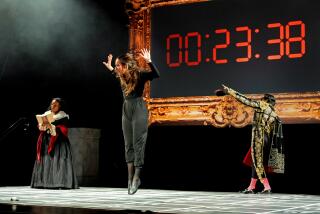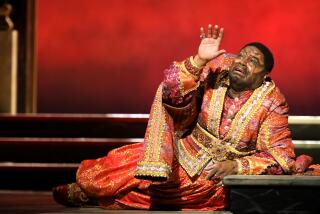Review: ‘The Flying Dutchman’ is earthbound on opening night
The composer Richard Wagner, born 200 years ago this spring, believed (with justification) that he represented the music of the future. Los Angeles likes to think (with justification?) that it represents the city of the future.
The two should be made for each other, and in the short history of Los Angeles Opera, they have been.
No company in America can match so interesting and original a string of Wagner productions over the past quarter-century as those at the Dorothy Chandler Pavilion, beginning with David Hockney’s gorgeous designs for “Tristan und Isolde” in 1987. L.A.’s. Wagner style has included Robert Wilson’s luminous “Parsifal” production, a proper S&M; orgy in “Tannhauser,” the wondrously wacky Achim Freyer’s “Ring” cycle and Julie Taymor’s complexly (if problematically) mythical and visually stunning “Flying Dutchman.”
PHOTOS: LA Opera through the years
On Saturday night, for the first time, the company replaced one Wagner production with another. Taymor’s 20-year-old “Dutchman” has made way for a less edgy futuristic one originally created by Lyric Opera of Chicago a dozen years ago. Even so, the future (as may seem depressingly appropriate in a town where four-fifths of its registered voters ignored the mayoral primary last week) is for the moment on hold.
The mildly provocative if already dated modernisms of Nikolaus Lehnhoff’s production, which San Francisco Opera picked up in 2004, was well liked in those towns with longer and more traditional Wagner traditions than ours.
Here, for the mythical tale of a forsaken Dutchman fated to wander the seas for eternity unless he can be redeemed by a sacrificing, selfless lover, an empty and fashionably industrial-spare ship’s interior serves as the setting. The seafarers have the intriguing style of space samurai.
But the real future is never what you expect. The evening held a surprise. Portuguese soprano Elisabete Matos, who was to have made her L.A. Opera debut Saturday as Senta (that Dutchman-besotted maiden whose calling is to serve as savior), felt too unwell to go on stage just as the curtain was about to go up. Her cover, Julie Makerov, made her own L.A. Opera debut with 12 minutes notice.
PHOTOS: Arts and culture in pictures by The Times
An Angeleno, USC grad and former member of the company’s chorus, Makerov has sung Senta in Toronto and Salzburg. She has strong high notes. She had the crowd’s support. She got the biggest hand of the night.
Makerov had her understandably unsteady moments. She had to watch her step — there was an large open pit in the center of the stage to worry about. She was expected to express solitary love. Senta and the Dutchman, who mostly stood behind her looking like a vampire sizing up her neck, rarely made eye contact in this production.
Under such circumstances, the soprano could hardly be expected to convey the qualities of being mystically transported. But there were no mishaps, which is at least a triumph of professionalism for an emerging singer faced with a major challenge. And she had her high notes.
Ultimately this proved a screwy “Dutchman,” if one strongly and fervently conducted by James Conlon. In a podcast, an essay in the program book and his trademark enthusiastic pre-opera talk, Conlon emphasized the outsider themes of Wagner’s breakthrough early opera. The Dutchman, Senta and her hapless fiancé, the hunter Erik (whom she basically ignores once the older, odder man comes on the scene), are meant to intrigue and win our sympathy because they don’t fit in.
Yet in this production — with sets by Raimund Bauer, costumes by Andrea Schmidt-Futterer, entrancing lighting by Duane Schuler and, for this revival, directed by Daniel Dooner — the outsiders look and act like regular, old-fashioned opera singers. The oddballs are the regular folk. And that was reinforced by Senta’s father, Daland (baritone James Creswell), the Steersman (tenor Matthew Plenk) and Senta’s nurse Mary (mezzo-soprano Ronnita Nicole Miller) having the strongest and most compelling voices and being the most convincing on stage.
They also got to wear the goofier costumes. But there is goofy and there is goofy. The look was reminiscent of Robert Wilson, but the movement was not slow and ritualistic, which produced a silly disconnect that, not surprisingly, generated inappropriate laughter from the audience.
It was not, however, unreasonable for Tómas Tómasson to be asked to approach the title role as that of a specter, but he took that too far. Rather than conveying a dominating vocal presence, he has the cool elegance of a lieder singer forced out of his vocal confort zone. Erik is not a winning role, and Corey Bix was not a powerful tenor.
The orchestra and the chorus have a lot responsibility in “Dutchman,” and they went a long way in carrying the show. Not only did both the men (the sailors) and the women (spinning cotton) have the best of the oddball costumes, they did in fact move more ritualistically while singing with winning fervor. The orchestra was one, maybe two, rehearsals or performances away from splendid.
L.A. Opera has a habit of not getting it right the first night. This first night had more extenuating circumstances than usual. A more compelling “Dutchman” could be just around corner.
‘The Flying Dutchman’
Where: Dorothy Chandler Pavilion, downtown L.A.
When: 2 p.m. March 17 and 24; 7:30 p.m. March 21, 27 and 30
Tickets: $19 to $309
Information: (213) 972-8001 or https://www.laopera.com
Running time: 2 hours, 15 minutes (no intermission)
MORE
INTERACTIVE: Christopher Hawthorne’s On the Boulevards
Depictions of violence in theater and more
PHOTOS: Arts and culture in pictures
More to Read
The biggest entertainment stories
Get our big stories about Hollywood, film, television, music, arts, culture and more right in your inbox as soon as they publish.
You may occasionally receive promotional content from the Los Angeles Times.







